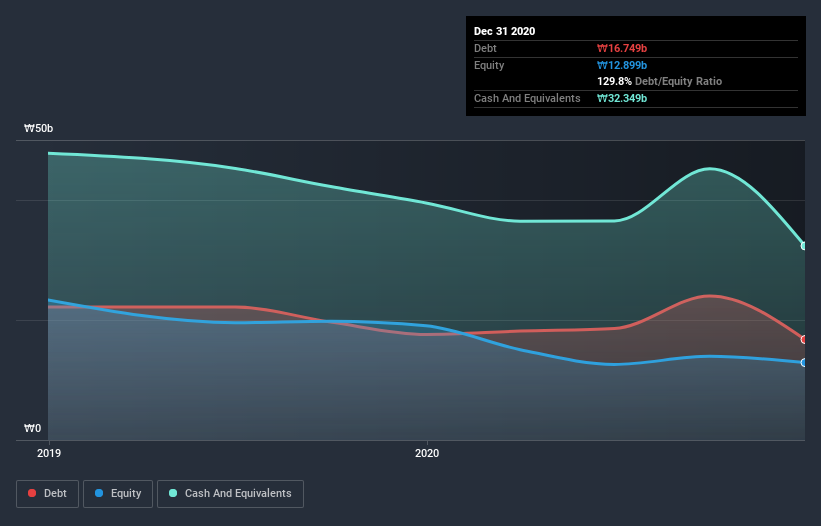
David Iben put it well when he said, 'Volatility is not a risk we care about. What we care about is avoiding the permanent loss of capital.' So it might be obvious that you need to consider debt, when you think about how risky any given stock is, because too much debt can sink a company. We note that EyeGene Inc. (KOSDAQ:185490) does have debt on its balance sheet. But is this debt a concern to shareholders?
Why Does Debt Bring Risk?
Debt assists a business until the business has trouble paying it off, either with new capital or with free cash flow. In the worst case scenario, a company can go bankrupt if it cannot pay its creditors. However, a more usual (but still expensive) situation is where a company must dilute shareholders at a cheap share price simply to get debt under control. Of course, plenty of companies use debt to fund growth, without any negative consequences. The first thing to do when considering how much debt a business uses is to look at its cash and debt together.
View our latest analysis for EyeGene
What Is EyeGene's Debt?
As you can see below, EyeGene had ₩16.7b of debt at December 2020, down from ₩17.6b a year prior. However, it does have ₩32.3b in cash offsetting this, leading to net cash of ₩15.6b.

How Healthy Is EyeGene's Balance Sheet?
We can see from the most recent balance sheet that EyeGene had liabilities of ₩8.49b falling due within a year, and liabilities of ₩23.0b due beyond that. Offsetting this, it had ₩32.3b in cash and ₩891.8m in receivables that were due within 12 months. So it actually has ₩1.71b more liquid assets than total liabilities.
Having regard to EyeGene's size, it seems that its liquid assets are well balanced with its total liabilities. So while it's hard to imagine that the ₩196.0b company is struggling for cash, we still think it's worth monitoring its balance sheet. Succinctly put, EyeGene boasts net cash, so it's fair to say it does not have a heavy debt load! There's no doubt that we learn most about debt from the balance sheet. But it is EyeGene's earnings that will influence how the balance sheet holds up in the future. So if you're keen to discover more about its earnings, it might be worth checking out this graph of its long term earnings trend.
Over 12 months, EyeGene made a loss at the EBIT level, and saw its revenue drop to ₩3.4b, which is a fall of 21%. That makes us nervous, to say the least.
So How Risky Is EyeGene?
We have no doubt that loss making companies are, in general, riskier than profitable ones. And the fact is that over the last twelve months EyeGene lost money at the earnings before interest and tax (EBIT) line. Indeed, in that time it burnt through ₩12b of cash and made a loss of ₩15b. While this does make the company a bit risky, it's important to remember it has net cash of ₩15.6b. That means it could keep spending at its current rate for more than two years. Even though its balance sheet seems sufficiently liquid, debt always makes us a little nervous if a company doesn't produce free cash flow regularly. The balance sheet is clearly the area to focus on when you are analysing debt. However, not all investment risk resides within the balance sheet - far from it. For example, we've discovered 3 warning signs for EyeGene (1 shouldn't be ignored!) that you should be aware of before investing here.
Of course, if you're the type of investor who prefers buying stocks without the burden of debt, then don't hesitate to discover our exclusive list of net cash growth stocks, today.
If you’re looking to trade EyeGene, open an account with the lowest-cost* platform trusted by professionals, Interactive Brokers. Their clients from over 200 countries and territories trade stocks, options, futures, forex, bonds and funds worldwide from a single integrated account. Promoted
Valuation is complex, but we're here to simplify it.
Discover if EyeGene might be undervalued or overvalued with our detailed analysis, featuring fair value estimates, potential risks, dividends, insider trades, and its financial condition.
Access Free AnalysisThis article by Simply Wall St is general in nature. It does not constitute a recommendation to buy or sell any stock, and does not take account of your objectives, or your financial situation. We aim to bring you long-term focused analysis driven by fundamental data. Note that our analysis may not factor in the latest price-sensitive company announcements or qualitative material. Simply Wall St has no position in any stocks mentioned.
*Interactive Brokers Rated Lowest Cost Broker by StockBrokers.com Annual Online Review 2020
Have feedback on this article? Concerned about the content? Get in touch with us directly. Alternatively, email editorial-team (at) simplywallst.com.
About KOSDAQ:A185490
EyeGene
Engages in the research and development of biopharmaceutical drugs for the treatment and prevention of age-related diseases in South Korea.
Flawless balance sheet low.
Market Insights
Community Narratives



